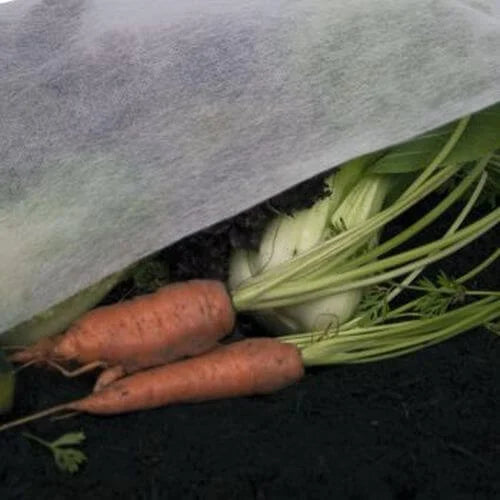Garden fleece is one of those handy tools every gardener should know about. It protects young or tender plants from frost, wind, and pests while still letting in sunlight and moisture. This guide explains what garden fleece is, the difference between light and heavy grades, and the best ways to use it throughout the year.
What Is Garden Fleece?
Garden fleece is a lightweight crop cover made from UV-stabilised, spun-bonded fabric. It’s designed to trap warmth and humidity while allowing air, water, and light to reach the plants underneath. It’s often used for frost protection on tender plants, shrubs, and early potatoes, and it can also speed up early crops in spring.
What Is the Difference Between 17g and 30g Fleece?
The numbers refer to the weight (grams per square metre) of the fabric. The higher the number, the thicker the fleece and the better the frost protection. Seventeen-gram fleece protects down to roughly –2 / –3 °C, while 30 g fleece can shield plants down to around –5 / –6 °C. Both grades still allow water, light, and air to pass through.
Can I Wash Garden Fleece?
Yes — you can wash garden fleece on a gentle or wool cycle. Allow it to dry fully before re-using or storing to prevent mildew.
How to Use Garden Fleece
Individual Shrub Protection
Wrap fleece around each shrub and tie securely with string at the base. This keeps frost off leaves and buds while still allowing ventilation and moisture exchange.
Greenhouse Insulation
In winter, 30 g fleece can be attached inside the glazing to create a simple double-glazing effect. In aluminium greenhouses, fix it to the bars using clips or double-sided pads; in wooden ones, drawing pins work well. We’ve created ready-to-use greenhouse insulation fleece kits to make installation easier.
Bedding Plants
Use fleece to protect bedding and tender plants overnight while they’re being hardened off. Remove the cover each morning to avoid overheating and keep airflow moving.
Crop Protection
Vegetables such as cauliflower and early potatoes benefit from fleece covers during frosty periods. Use 30 g fleece in cold spells and remove it during mild, wet weather to prevent damping off. Secure the edges with clips or pegs, and leave early potatoes covered until all risk of frost has passed.
Re-use and Cutting
Garden fleece can be reused several times if handled gently. It cuts cleanly with sharp scissors and should be stored out of direct sunlight in a dry, pest-free place when not in use.
